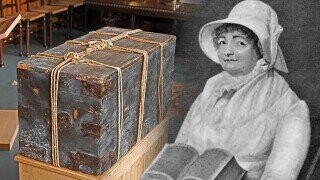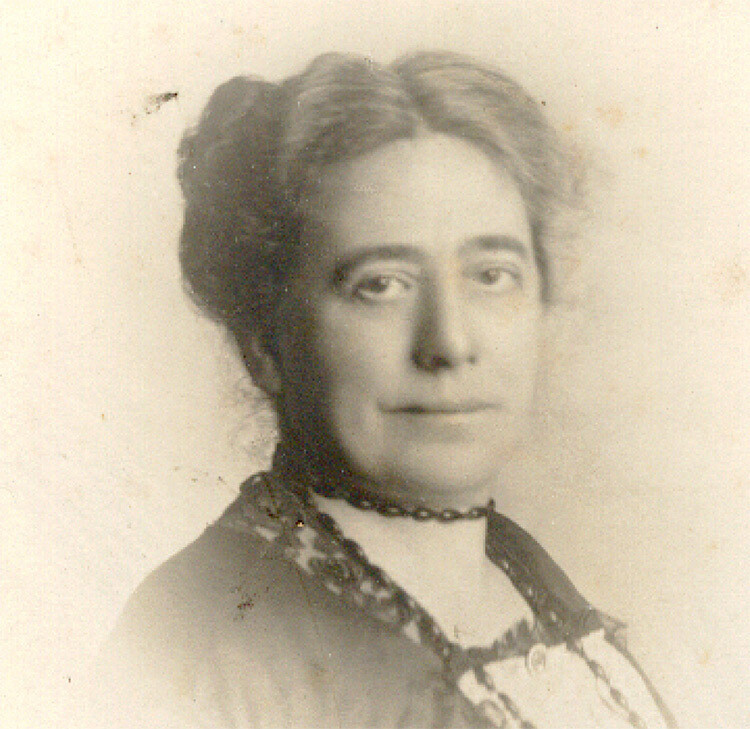Cracked's Oofageddon! - The Woman Who Was Pregnant With The Messiah (At 64)

Welcome to Oofageddon! a.k.a. Cracked's ongoing exploration of apocalyptic predictions that couldn't cut the mustard. Today's non-cataclysm: the mystical pregnancy of Joanna Southcott.
For as long as we’ve recorded history, people have claimed history is coming to a close. Fringe theologians have said divine judgement is at hand, rogue mathematicians have warned that the universe is about to unleash countless horrors, and generally crazy people have screamed that aliens and monsters will destroy us all. Oofageddon! could start anywhere, but let’s start with Joanna Southcott.
Born in 1750 in a small British hamlet, most of Southcott’s life was unremarkable. She helped out on the family farm, then found work as a domestic servant. She never married or had children. In 1792 she joined the mundane and mainstream Wesleyan Church. And then, she started claiming she was the Woman of the Apocalypse.
Don't Miss
If you haven’t read the Book of Revelation lately, the Woman is part of an elaborate story involving a dragon that’s generally accepted as a metaphor for how dramatic and awesome it was that Mary gave birth to Jesus. While more stories of childbirth should involve dragons, that one was already taken.
But Southcott, who’d begun spitting out rhyming prophecies like a boardwalk fortune-telling machine, gained a small following. Eventually she was invited to London by William Sharp, an engraver whose last messiah, Richard Brothers, had been thrown in an insane asylum for claiming to be a miracle worker who spoke for Christ and prophesying the imminent downfall of the monarchy. Sharp, apparently not a man to be easily discouraged, ditched his old saviour and latched onto Southcott instead.
Sharp paid for Southcott to live in London at no small cost, although some living expenses were recuperated by the pair selling Seals of the Lord, fancy pieces of paper that would guarantee their holders a place among the 144,000 elect in heaven (everyone who didn’t pony up, as Jesus famously said, would be SOL).

2jenn/Shutterstock
That makes them sound like mere grifters but, whatever else Southcott was, she was a true believer in herself. And her fan club was growing -- the mass media tools the smarty-pants of the Enlightenment thought would stamp out such nonsense actually just made the nonsense easier to spread, because sometimes history just lobs the parallels to modern day through your roof. For the next couple decades, Southcott spat out prophecies and warned the end was nigh, which was unusual but not exactly unheard of. She was famous enough to be mentioned in A Tale of Two Cities, but to most of Britain she was just another crank. Then, in 1814, Southcott claimed she was carrying the next Messiah.
That was an impressive feat for a 64-year-old virgin, and Southcott upped the ante by saying Messiah 2.0 would be born on October 19 and bring the end times with him. This earned her a lot of public mockery, but also more followers, and a gilded cradle and beautiful clothes were dutifully prepared. Supposedly she had 100,000 believers, although some probably started doubting her when the baby failed to appear. Those doubts presumably grew when Southcott died two months later.
Southcott’s “pregnancy” was likely abdominal swelling caused by a medical condition that killed her, and you’d think the story would end there. People claiming to be or be carrying the next Messiah are littered throughout history, but most of their little movements scatter upon the demise of their would-be savior. Not so, however, with the Southcottians.
Southcott left two legacies: more prophets, and a mystery box. The box, supposedly full of Southcott’s prophecies, came with instructions to only be opened during a time of national crisis, and then only in the presence of the 24 bishops of the Church of England, who were required to spend the days before the big reveal studying and praying over Southcott’s earlier writings.
Southcott’s followers begged the Church to do just that during the Crimean War, and again during World War One. The Church, shockingly, declined. In 1927 Harry Price, a man who’d made a career out of debunking spiritualists, mediums, and other hoaxers, claimed the box had been sent to him, and upon opening it found dice, a lottery ticket, a night cap, earrings, a purse, and other bric-a-brac that probably wouldn’t have stopped the German war machine.
Southcottians, however, claimed the box was fake, and that they’d squirrelled away the real one. They were taking out newspaper ads calling on the Church to meet their terms as late as the 1970s. Here’s a billboard they put up in Piccadilly Circus in 1932 claiming “Crime and Banditry, Distress and Perplexity will increase in England until the Bishops Open Joanna Southcott's Box.”

But hang on, how did this lady still have followers well over a century after her death? Southcott had a number of claimed successors, beginning with John Ward. An Irish shoemaker turned preacher, he studied Southcott’s writings and in 1828 declared himself to be the messiah she spoke of. You see, he’d been sent to a workhouse after his family worried his claim of receiving a divine mission was a sign of madness, and upon release he said he had become a “new man.” Southcott’s pregnancy, conveniently, was figurative.
Ward, now calling himself Zion, didn’t let little details like the Southcottians refusing to acknowledge him stop him from preaching in Joanna’s name. He was apparently persuasive and funny, at least until he went to jail for blasphemy. Ward somehow became a minor celebrity as politicians and media, outraged at legal overreach, campaigned for clemency, and after 18 months Ward was freed to preach until his death.
Later, two women with the incredibly old-timey names of Mabel Barltrop and Alice Seymour both claimed to be Southcott’s true successor. Seymour, born in 1857, read Southcott’s writings as a child, presumably because her parents didn’t have any good books kicking around, and in 1907 she claimed to be visited by spirits who tasked her with writing a biography of Southcott. Apparently the spirits also told her to co-write with a Reverend who had died two years prior, but she soldiered on regardless and the book was surprisingly well-received.
Seymour followed this success with the republication of Southcott’s work, a magazine dedicated to Southcott, and a campaign to finally open the mystery box, but was stymied by Baltrop. Baltrop was a few years younger and had first learned about Southcott from one of Seymour’s pamphlets, but she went way, way harder. Like, claim the Southcott society she founded in sleepy Bedford was where the Garden of Eden once stood hard.
Like Ward, Baltrop claimed to be the messiah Southcott foretold. At the suggestion of her followers, Baltrop declared herself the Daughter of God, rechristened herself Octavia, and humbly reworked the trinity into a quadrinity that included her. Every day, Octavia would sit down and write the divine thoughts of the holy spirit as they were channelled through her, eventually producing 16 volumes.

Baltrop’s church of about 70 followers was officially called the Panacea Society, and as cults went they were a bit freewheeling. For starters, they thought the world would collapse into darkness if not for their work. The group humbly awaited the second coming of Christ until 1923, until Baltrop decided that her dead husband had been Jesus and it was actually the third coming of Christ that was on tap. She thought Satan would attack her if she left the house. And when Baltrop died in 1934, her followers let her body sit for three days before they accepted that she wasn’t coming back.
Both the Panacea Society and Seymour’s rival group saw their membership decline in the 1930s and ‘40s, but the Society, buoyed by millions of dollars worth of property and antiques, clung to life until 2012. They generated hundreds of thousands of requests to finally open Southcott’s box, and they sent small pieces of linen blessed by Baltrop to anyone who asked for one because it could cure all diseases. So that was handy.
By the 1960s the Society’s membership had dwindled to around 30, and in 2012 the last member died. The Society then became the Panacea Charitable Trust, which runs a Southcott museum and funds academic studies on the broader world of propheteering.

Today, two tiny churches—one in the UK and one in Michigan—still follow Southcott’s teachings. The latter, called the House of David, also happened to found a barnstorming, showboating, Southcott-preaching baseball team that featured future Hall of Famers Satchel Paige and Mordecai Brown, but that’s a different story.
The point of all this is that for every murderous Jim Jones there’s someone out there saying “Yes, Christ’s return to Earth is imminent and humanity will face a terrible judgement when He arrives, but until then let’s just live in this nice house together.” Maybe you can’t call Southcott and Baltrop good people, but in their own weird way they were genuine. Their followers—mostly older, unmarried Victorian women—saw the world passing them by, and they carved a strange little something out of it anyway. Still, as a general rule, when a 64-year-old says they’re carrying our next savior, maybe just get them a doctor.
Mark is on Twitter and has a brand new collection of short stories.
Top image: Alan Denney/flickr
You can check out further installments of Oofageddon! below:
In 1844, Americans Sold All Of Their Stuff Because Jesus Was Coming Back
In 1910, Americans Thought Halley's Comet Was A Doomsday Event
In The '60s, The Truly Devoted Believed Aliens Would Save Us From Nukes
In The 1970s, A Bestseller Claimed The Planets Would Align And Destroy Everything